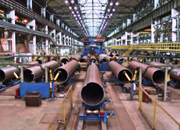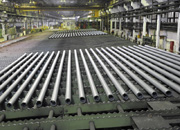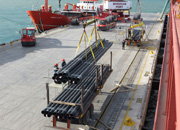In modern industrial construction and energy transmission,
high-strength welded steel pipes (high-strength straight seam welded steel pipes/high-strength straight seam steel pipes) have become core materials in oil and gas transportation, building structures, and machinery manufacturing due to their superior mechanical properties and process adaptability. Their technological development and application reflect breakthroughs in materials science and the transformation trajectory of China's manufacturing industry from scale expansion to quality upgrading.
First, the technical definition and process breakthroughs of high-strength straight seam steel pipes.
High-frequency straight seam welded steel pipes (HFW), as the mainstream product of high-strength straight seam steel pipes, use hot-rolled coils as raw materials. The metal is instantly melted through the skin effect and proximity effect of high-frequency current, and welding is completed under the action of extrusion rollers. Compared with traditional spiral welded steel pipes, its weld length is reduced by more than 30%, and due to the narrow heat-affected zone and refined grain, the tensile strength can reach over 555MPa (such as X80 grade pipeline steel), and the impact toughness is improved by 20%-30%. Domestically advanced production lines have achieved wall thickness precision control of ±0.1mm, covering a diameter range of Φ20mm-Φ660mm, meeting international standards such as API 5L and GB/T 3091. Supported by microalloying technology, modern high-strength welded steel pipes, through the addition of trace elements such as niobium, vanadium, and titanium, form nanoscale carbonitride precipitates, maintaining the weldability of the steel while achieving a synergistic improvement in strength and toughness. A technical report from a steel plant indicates that X90 grade welded steel pipes produced using TMCP (Thermomechanical Control Process) can have a yield strength ratio controlled below 0.85 and an impact energy exceeding 100J at -40℃, significantly superior to products produced using traditional processes.
Second, Application Scenarios and Performance Advantages of High-Strength Straight Seam Steel Pipes.
1. Energy Transmission Sector: In the West-East Gas Pipeline III project, the application of X80 high-strength straight seam welded steel pipes reduced pipe wall thickness by 15%, increased single-pipe pressure capacity to over 12MPa, and increased annual gas transmission capacity to 45 billion cubic meters. Analysis of a certain pipeline shows that this material reduces the number of weld joints in mountainous sections by 20%, significantly lowering the risk of circumferential weld failure. The Φ1420mm steel pipe used in a natural gas project has set a global record for the application of large-diameter, high-strength steel pipes.
2. In the construction and machinery sectors: The use of Q690D high-strength welded steel pipes in high-rise building steel structures has reduced component weight by 25%-30% and increased the ductility coefficient of seismic joints by 1.5 times. One company has achieved a strength of 1200MPa and a fatigue life of over 500,000 cycles using steel pipes. It is worth noting that pre-strain strengthening technology (such as 2% pre-tensioning) can further increase the yield strength by 10%-15%, making it particularly suitable for ultra-large span spatial structures.
Third, Industry Pain Points and Innovation Directions for High-Strength Straight Seam Steel Pipes.
- Weld Quality Control: Welding speeds exceeding 20m/min are prone to incomplete fusion defects. One company reduced the scrap rate from 3% to 0.5% by using a plasma monitoring system.
- Corrosion Protection Bottleneck: Deep-sea pipelines need to withstand 15MPa external pressure + H₂S corrosion. A new 3PE anti-corrosion layer combined with sacrificial anode protection extends the design life to 40 years.
- Cost Optimization Needs: One company developed a "hot-for-cold" technology, using 600℃ low-temperature rolling instead of traditional cold forming, reducing production costs by 18%. Future technological evolution will focus on three dimensions:
1. Materials Genome Engineering: Optimizing alloy composition through big data simulation, with the goal of achieving industrial-scale production of X120 grade welded steel pipes by 2028;
2. Intelligent Welding Systems: Real-time weld seam tracking technology based on machine vision is expected to increase the welding qualification rate to 99.9%;
3. Green Manufacturing: The Hydrogen reduction ironmaking process can reduce CO₂ emissions by 30%, and combined with the electric arc furnace short-process, it forms a low-carbon product throughout its entire life cycle.
Fourth, Market Prospects and Domestic Production Progress of High-Strength Straight Seam Steel Pipes.
The global market size for high-strength welded steel pipes exceeded US$38 billion in 2024, with China accounting for 34%. It is worth noting that domestically produced high-end products are breaking the international monopoly:
- A company's Φ1219mm X80 steel pipe, developed in preparation for development, passed a certification and won a bid for a 1600km long-distance pipeline;
- A company's high-strength, crush-resistant oil casing for shale gas has reduced the cost per well by 2 million yuan.
- A company's 18-meter ultra-long welded steel pipe has reduced butt welds on offshore platforms by 15%.
However, in areas such as ultra-thin-walled (<6mm) large-diameter welded steel pipes and -60℃ low-temperature steel pipes for polar applications, imports are still essential. Industry experts suggest strengthening collaborative innovation among industry, academia, research, testing, and application, focusing on breakthroughs in "bottleneck" technologies such as online heat treatment and full-size automatic testing.
From material properties to engineering applications, the technological iteration of high-strength straight seam welded steel pipes has never stopped. Driven by the "dual carbon" goal, this industrial masterpiece, integrating metallurgy, mechanics, and manufacturing processes, will continue to drive infrastructure towards a safer, more efficient, and more sustainable direction. As one engineer said on a technical forum, "The cross-section of every welded steel pipe is a masterpiece of mechanics in the microscopic world." This technological beauty hidden in steel is a vivid testament to the rise of Chinese manufacturing to the high end.
 Threeway Steel is known as a professional supplier engaged in manufacturing and distributing a wide range of steel pipe, and our headquarter located the central part of China – Hunan and six associated factories throughout China.
Threeway Steel is known as a professional supplier engaged in manufacturing and distributing a wide range of steel pipe, and our headquarter located the central part of China – Hunan and six associated factories throughout China.
 Threeway Steel is known as a professional supplier engaged in designing, manufacturing and distribution of a wide range of steel products with the headquarter located the central part of China – Hunan and six associated factories throughout China.
Threeway Steel is known as a professional supplier engaged in designing, manufacturing and distribution of a wide range of steel products with the headquarter located the central part of China – Hunan and six associated factories throughout China.
 Threeway Steel is known as a professional supplier engaged in designing, manufacturing and distribution of a wide range of steel products with the headquarter located the central part of China – Hunan and six associated factories throughout China.
Threeway Steel is known as a professional supplier engaged in designing, manufacturing and distribution of a wide range of steel products with the headquarter located the central part of China – Hunan and six associated factories throughout China.
 Threeway Steel is known as a professional supplier engaged in designing, manufacturing and distribution of a wide range of steel products with the headquarter located the central part of China – Hunan and six associated factories throughout China.
Threeway Steel is known as a professional supplier engaged in designing, manufacturing and distribution of a wide range of steel products with the headquarter located the central part of China – Hunan and six associated factories throughout China.
 Threeway Steel is known as a professional supplier engaged in designing, manufacturing and distribution of a wide range of steel products with the headquarter located the central part of China – Hunan and six associated factories throughout China.
Threeway Steel is known as a professional supplier engaged in designing, manufacturing and distribution of a wide range of steel products with the headquarter located the central part of China – Hunan and six associated factories throughout China.

